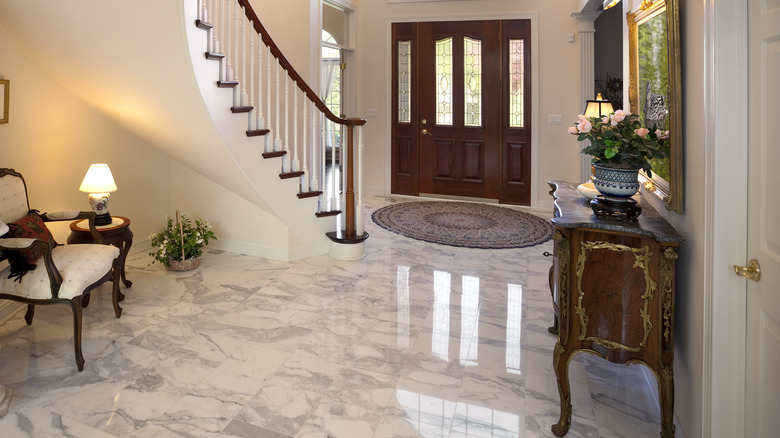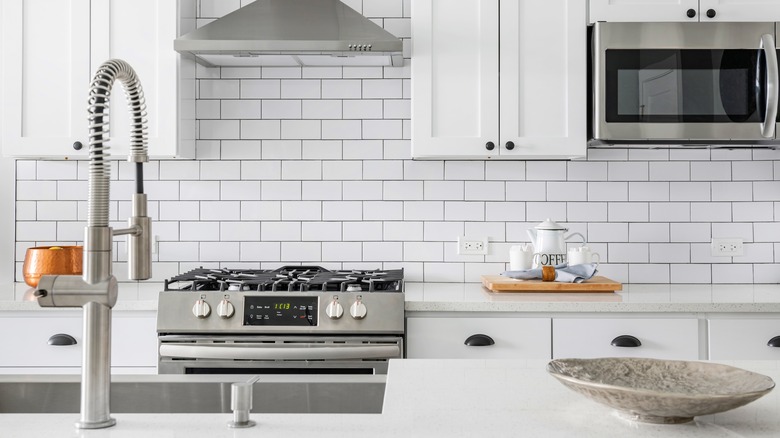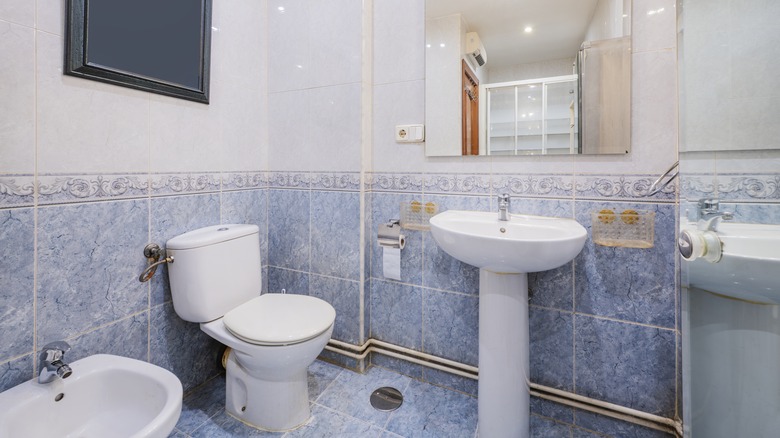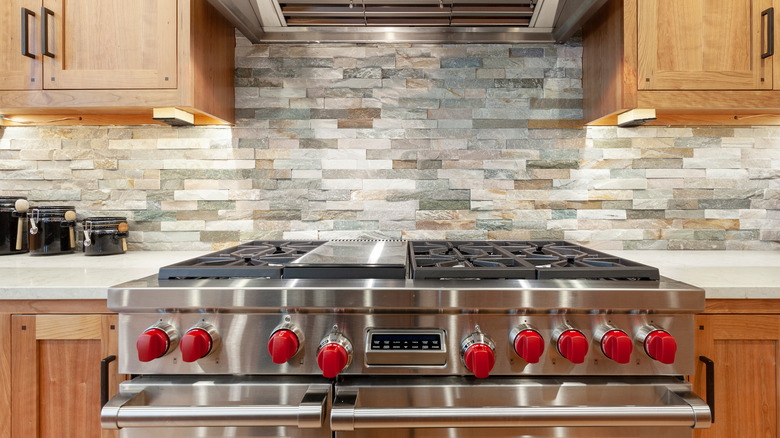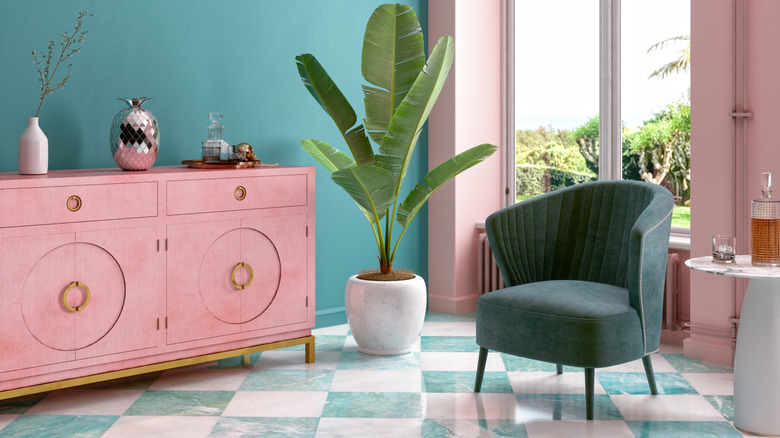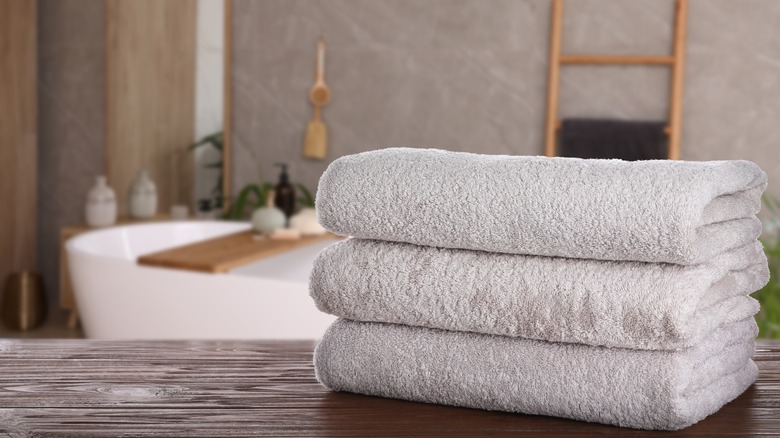Tile Trends Our Flooring Experts Warn To Avoid At All Costs
There's nothing quite as alluring as a really good tile trend. The last few years have given birth to some super sexy tile work, including cheeky, carefree terrazzo looks, sultry, high-gloss finishes, and confident colors like electric blue, emerald green, and other jewel tones. But, unless you have the budget (and the mental resilience) to remodel every few years, opting for ultra-trendy tile designs is risky business. Tile is one of the most expensive finishes to replace in a home, typically costing anywhere between $5-$45 per square foot. They're a very permanent choice, and you don't want to pick something you'll tire of or that turns out to be impractical.
To help you navigate tile styles like a pro, House Digest conducted exclusive interviews with two industry experts. They shared their insights on the tile choices most likely to trigger regrets. So, before you get tempted to participate in a tile trend that's doomed to look dated from the start -– sit tight and see what the pros have to say on natural stone, subway, high-gloss tiles, and more.
High-gloss tiles in high-traffic areas
After falling from favor in the early aughts, high-gloss tiles are back with a bang. If you've been browsing inspo pics, you're sure to have seen some super shiny zellige tiles, with so much sheen they look almost lacquered. High-gloss tiles don't just feel exciting, they also have certain practical benefits. They can bounce extra light around and even create the optical illusion of more space. But, glossy tiles might not be your best bet for a high-traffic zone. During an exclusive interview with House Digest, Danielle Lancianese, Director of Tile and Stone at Shaw Floors, said, "High gloss tends to show more dirt or smudge marks. Although tile is easy to clean, I find that you see more dirt, scuff marks, etc. when you place a high gloss in a high-traffic area."
Fortunately, if you have your heart set on a shiny tile selection, there are smart ways to still incorporate it, even in the busiest of bathrooms or hallways. One trick is to create a combination of matte and gloss tiles in the same design. As Danielle Lancianese explained, 'Most product lines today offer a matte version in the same visual along with the polished version. So, homeowners can use the matte on the floor as a substitute and place the polished on the walls or accent wall to still feature the beauty of a polished product." This has the added benefit of providing extra traction underfoot. Another beautiful way you can execute this tip is by creating a two-toned wall, running matte tiles up midway, and then switching to gloss. This will add visual interest and create a contemporary take on the traditional chair rail look.
White subway tiles are naturally falling out of favor
Subway tiles have been lining backsplashes, shower walls, and subway stations for more than a hundred years at this point. During the early 1900s, it was seen as the pinnacle of clean-lined, sanitary modernity. Fast forward to the start of the 2000s, and subway tile was surging in popularity once more. Beloved by bloggers, influencers, and everyone in between, it injected the perfect touch of timeless tradition without being too busy, bold, or bright. But it seems that the iconic finish is slowly falling out of favor. During her exclusive interview with House Digest, Lancianese shared, "A trend I notice homeowners staying away from on their own is plain white subway tile."
Unlike less classic tile styles, subway is still a safe choice, but it can feel a little basic. The good news is that you can easily add interest through different layouts and grout choices. When it comes to straight-laced white subway, Lancianese says, "I think it is great and versatile, but there are so many more opportunities out there for a homeowner to express him or herself with shape, color, or texture." If you want to get a fresh feel, look beyond the classic formats and grouting pairings. Narrower, elongated styles can give you a very current look, especially if you use a contemporary layout like vertical stacks. Unusual grout colors like brown, yellow, or even orange can elevate simple subway to editorial status. If you already have subway tile installed, re-grouting in a new hue can be a cost-effective, fun facelift. You can also go in the opposite direction by picking a grout color that closely matches your tiles to create a seamless look.
Listellos look a little dated
Getting funky with your tile design is fine, as long as the patterns and decorative accents are going to last. Unfortunately, this is not the case with accent banding. Lancianese told House Digest "I would warn homeowners of accent banding, also known as listellos." Accent banding was big back in the 90s and early 2000s, but it's not something you'll see in newer installations. "Most tile installs have a seamless look to them now versus putting a band in the middle for visual interest." There are many '90s and early aughts trends dominating design (such as chrome and classic hunter green), but accent banding is a good example of how not all trends come back around.
So unless you're looking to revive the Tuscan interior trend, leave listellos out of your tile design. There are many other ways you can add decorative details to your tile work without resorting to accent bands. Penny tiles with contrasting border frame designs can offer a contemporary and timeless alternative, and you can use them to create tile rugs. "Tile framing" is also turning into an interior-designer-approved trend that can help elevate simple choices. If you want a more minimalistic look, consider using two different tones of the same tile in one space. For instance, you can run a darker tone midway up the wall in a powder bath and then take the rest to the ceiling in a slightly lighter shade.
Unsealed natural stone is a no-no
Nothing whispers upscale luxury and deep pockets like natural stone tile. Not only is it inherently beautiful, but it's also not cheap and tends to be high-maintenance. Sealing stone floors and counters is a common practice, but there seems to be some confusion about whether sealing is necessary for backsplashes. Spoiler alert: it most definitely is. Lancianese told House Digest, "I would steer clear of the misconception around natural stone. Several customers, designers, and home buyers I've talked to think you can install natural stone as a kitchen backsplash and NOT seal it. You absolutely should seal it, no matter where it's installed ... Nothing pains me more than to see a grease or spaghetti sauce stain on a beautiful natural stone tile."
Besides having natural stone tiles sealed initially, you also need to be prepared for regular maintenance. Stone floors need resealing every few years at least. At some point, you may also need to strip them of sealant buildup. Marble tile showers and floors may need periodic polishing to remove scratches and surface stains. Speaking of stains, prepare yourself for some patina. "Natural stone is a beautiful product but requires more upkeep, even if you aren't walking on it every day. It's porous, so it's naturally going to absorb whatever moisture comes in contact with the surface." Does this all sound like too much? Don't feel bad about going the faux route. Lancianese says, "If you aren't up for the upkeep of natural stone, then we have the next best thing, which is a tile/mosaic that is digitally printed on to mimic the look of natural stone but without the upkeep. No sealing required!"
Floor tiles with strong colors have poor lasting power
After years of paired-back color schemes, bolder palettes are making a big comeback. While bright hues can help add energy to your interior, if you're renovating your flooring, this is probably not the place to experiment with dopamine decorating. Daring colors might feel exciting in the moment, but they tend to be less timeless. In an exclusive interview with House Digest, Alex Moody, senior Hard Surfaces Designer of COREtec, said, "I would suggest avoiding anything with particularly strong colors for the floor, since overall, the color palette for the home is trending towards warm neutrals." Not only do vivid colors date faster, but they can make it hard to create a new cohesive color scheme when you want to repaint or update furniture.
"People expect to have some longevity with their floor and style choices, and finding a grounding neutral with warmer undertones is a safe bet. The floor has a fundamental effect on setting the tone for the space, so allowing for versatility and personalization will ensure the best longevity," mentions Moody. If you're thirsting for some saturation, look toward finishes that are cheaper and easier to alter, such as paint. You can also inject color and personality through movable furnishings, rugs, and accent pieces. Things like bold art and bright textiles will pop against a neutral background instead of having to compete for space.
Tiles that don't match the mood you're trying to create
It's easy to get carried away looking at mouthwateringly beautiful pictures of interiors, but don't let alluring inspiration images distract from what you need specifically from your space. During his interview with House Digest, Alex Moody advised, "I would highlight focusing on the goals for the room that you are designing when selecting materials." In other words, how do you want your home to make you feel? According to Moody, "Consumers are reevaluating their spaces in terms of the mood or feeling they get while living in their homes. For example, many consumers are searching for a sense of respite and a grounding, restorative feeling in their homes." As an example, he mentions how CORETec's Embra Slate tile with "its deep tone and weight helps bring a sense of stability and restoration to a bathroom."
Darker tilework tends to have a grounded, sophisticated, and dramatic feel. It can also add visual depth and create an enveloping sensation in smaller spaces like powder baths, showers, and wet rooms. On the other hand, if you, too, want your home to feel like a calm sanctuary, light neutrals, and muted tones can give a soft, soothing feel and offer sensory relief. If you want to add some interest and energy without using bold colors, consider smaller tile formats or interesting layouts such as herringbone or basketweave patterns. Using more than one type of tile in a space can also create a subtly dynamic feel.

